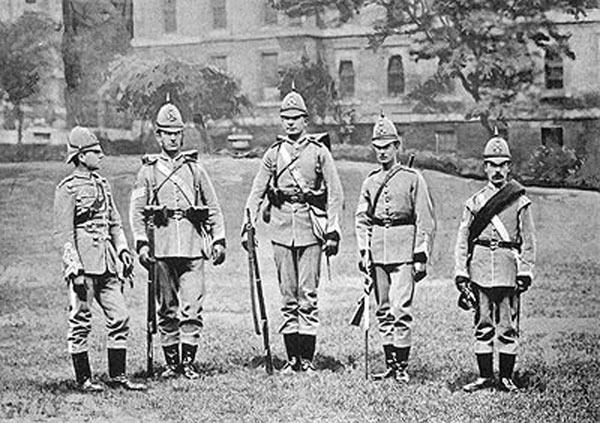1st Volunteer Battalion
The Queen's (Royal West Surrey Regiment)
For many years the Regular Regiments of the British Army have been supported by reserve and auxiliary units such as Volunteers, Militia, Yeomanry and Territorial Forces. In these respects the county of Surrey has not been lacking in providing “men-at-arms”. The 1st Volunteer Battalion, The Queen’s dates its existence from the year 1859 which saw the commencement of the Volunteer movement in its subsequently existing form. With Headquarters at the barracks at Mitcham Road, Croydon the Battalion had outlying companies at the Crystal Palace and Caterham and detachments at Oxted and Merstham. Enthusiasm must have been strong as those who enrolled had to provide their own uniform arms and equipment and also pay for instruction. The original cost to each man was £8 - a not inconsiderable sum in those days.
 |
| (Click to enlarge) 1st Surrey (South London) Rifle Volunteers. |
In 1867 the War Office re-organised these companies as a battalion with an establishment of six companies, giving it the title of the “2nd Surrey Rifle Volunteers”. The uniform was rifle green and the shako was worn until 1877 when the helmet was substituted.
After some further re-organisations the Battalion was linked to The Queen’s and became the 1st Volunteer Battalion, The Queen’s Royal (West Surrey) Regiment. By 1885 the strength of the Battalion was about 900, a quite considerable force, and in 1891 the “Blakney” leather equipment was adopted as part of the uniform. The barracks in Mitcham Road remained the Headquarters while the Range, which was situated near Marden Park, was reputed to be one of the finest in London. An annual camp was held when, as on other manoeuvres, all travelling expenses were paid and rations provided free.
The whole aim of the Volunteer Battalion was to provide a man enabled “to take his proper place in the defensive scheme of the Empire should the necessity arise”. That the aim had been achieved was amply demonstrated at the time of the South African War when the Battalion sent five officers and over 200 men to the conflict. Thankfully the volunteer spirit survived into the twentieth century especially through two World Wars, and still continues Regimentally today.
Regulations of the First Regiment of Surrey Volunteers 1803
On the subject of Volunteer Regiments, the above mentioned Regulations make interesting reading as some examples show.
In 1803 the late Volunteer Corps of Bermondsey, Loyal Bermondsey, Newington and Rotherhithe agreed to unite and form one Corps under the title of The First Regiment of Surrey Volunteers. The Regiment was to be commanded by Lieutenant Colonel Thomas Gaitskell with Major Thomas Burne as his Second-in-Command.
There were four Divisions which were sub-divided into a total of six Companies, each of which was commanded by a Captain assisted by a Lieutenant and Second Lieutenant. The Chaplain was The Rev Henry Cox Mason while the Surgeon was Samuel Henry Sterry. The defined purpose of the Regiment was, “To aid and assist the Civil Power within five miles of the Obelisk in St George’s Fields; but in case of actual Invasion, or the Appearance of the enemy on the Coast, for that purpose, the Services of the Regiment to extend to the London Military District.” Each member had to provide his own uniform and accoutrements at his own expense and agree to serve without pay or emolument.
Captains of Companies could enlist “such Gentlemen as may be desirous of becoming members” provided they were considered suitable. Affairs of the Regiment were to be conducted by a Military Committee of Commissioned Officers. The Lieutenant Colonel could call out the Regiment whenever he deemed it necessary but Field Officers and Captains could appoint Field Days. Divisions were to render utmost assistance in the protection of property on occasions of fire in the neighbourhood and were to “muster in undress uniform” when called on for the purpose. From this, and the definitive order of “aid to the Civil Power”, it will be seen that the Regiment was intended to carry out duties which were later to become the responsibilities of professional police and fire brigades.
Any emergency requiring a full muster of the Regiment was to be signalled by drummers beating “To Arms” around the respective parishes. Failure to respond when ordered out for duty was a disciplinary offence which could be dealt with by a Court of Inquiry as convened by the commanding officer. Any officer or member of the Regiment leaving town for more than seven days had to signify the same to the Captain of his Company, otherwise such excuse could not be allowed for any neglect of duty. Uniform was not to be worn except when on duty or on “military occasions”. When so worn the full dress uniform was obviously a colourful affair consisting, with embellishments and trimmings, of a scarlet jacket, white breeches, white waistcoat, black silk stockings, helmet with bear skin and regulation feather, and lastly black cloth gaiters. Hair was to be “powdered and dressed close”. Undress uniform was a lower key affair consisting of a blue jacket, white pantaloons and full dress helmet.
History should well remember the old time Volunteers as they set standards of discipline and service which have been inherited throughout the years and are still embodied in the re-organised and re-named volunteer units of today.
Those were the days!
Related
